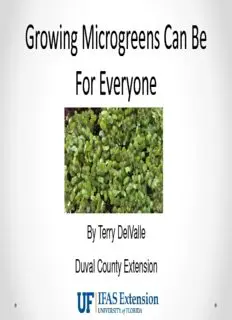
Growing Microgreens Can Be For Everyone PDF
Preview Growing Microgreens Can Be For Everyone
Growing Microgreens Can Be For Everyone By Terry DelValle Duval County Extension BYOM • Birth your own microgreens • Started in 1980s in San Francisco What are Microgreens? • Young, tender greens used to enhance color, texture or flavor of salads or to garnish main dishes • Harvested at cotyledon or 1st true leaf stage; used with stem and leaves attached • Vegetable confetti Sprouts, Microgreens, Baby Greens • Sprouts: youngest and smallest; germinated seeds without true leaves; eat entire plant o Highest risk microbial contamination; heavily regulated o • Microgreens: ~2” tall • Baby Greens: ~3-4” tall; oldest and largest • Microgreens and Baby Greens: no legal definition; marketing terms; not eating roots Shoots • Like microgreens, harvested with stems and leaves when they reach desired size (3” to 5” tall) • Sunflower, buckwheat, field pea, tendril pea, hard red winter wheat, nasturtium, popcorn 80-100 Crops/Crop Varieties • Cabbage • Carrot • Beet* • Cress • Kale • Arugula • Kohlrabi • Basil • Mizuna • Onion • Mustard • Chive • Radish • Broccoli • Swiss chard • Buckwheat • Amaranth • Cilantro • Tatsoi • Lemongrass Fast Growing Microgreens • Red cabbage • Mizuna • Chinese cabbage, Kogane • Mustards except red • Collard, Champion giant • Cress, Cressida • Pac Choi, Rosie • Cress, Persian • Radish • Hon Tsai Tai • Tatsoi • Kale, Red Russian & Tuscano • Kohlrabi Slow-Growing Microgreens • Amaranth, Garnet Red • Orach, Ruby Red • Arugula • Pac Choi, Red Pac • Beets • Purslane, Red Gruner • Carrot • Scallion, Evergreen • Chards Hardy White • Komatsuna • Shungiku • Magenta Spreen • Mustard, Red Giant Slow Growing Microgreen Herbs • Anise • Marigold, Gem • Anise Hyssop • Parsley • Basils • Salad Burnet • Chervil • Saltwort • Cilantro • Shiso, Britton • Cutting Celery • Sorrel • Dill • Fennel • Lemon Balm Basils Cressida Cress Tatsoi Red Garnet Amaranth
